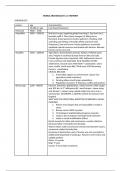'Hitler became Chancellor in January 1933 mainly as a result of ‘backstairs intrigue’.
Assess the validity of this view.
Hitler’s chancellorship commenced on the 30th January 1933 and can partly be credited to
the ‘Backstairs intrigue’. These were the negotiations between Hindenburg, Schleicher and
Papen to use Hitler as a tool to create a functional government. In this, it could be argued
that Hitler’s appointment as Chancellor was arguably because of the plan devised by
Hindenburg’s ‘inner circle’. That said, it would also be pertinent to analyse other factors that
led to Hitler’s appointment such as; the economic depression, which led to the increase in
support for Nazi party, and the political strength derived from Hitler’s character.
It can be argued that Hitler became Chancellor as a direct result of the ‘Backstairs intrigue’,
and the great influence of Hindenburg’s ‘inner circle’. The influence of Hindenburg's ‘inner
circle’ can be seen in Schleicher’s persuasion to trigger the downfall of Brüning’s
government in 1932, appointing Papen in his place. At first, Hindenburg despised who he
described as a ‘Bohemian Corporal’ but after his son Oskar and Von Papen pressured
Hindenburg, he began to concede the idea of a Hitler chancellorship. Without Von Papen
convincing Hindenburg that he would ‘Make Hitler squeak’ the possibility of Hitler becoming
Chancellor was highly unlikely. He also coerced Hindenburg with the idea that Hitler would
be surrounded by conservatives and thus easy to control. Papen and Oskar both believed
that Hitler would be a puppet, allowing for a well functioning government due to Hitler’s
electoral success - 33% in Nov 1932. Alan Bullock further supports this view as he believes
that ‘Hitler was jobbed into power by the Backstairs Intrigue’. This clearly demonstrates that
Hitler’s chances of becoming Chancellor were very small and thus highly unlikely, if it was
not for the ‘Backstairs intrigue’.
Although the ‘Backstairs intrigue’ did contribute to Hitler becoming Chancellor in the short
term, a more prolonged and important reason was the proliferation of support for the Nazi
party and Hitler as a result of the economic depression. Before the Wall Street Crash,
support for the democracy was at its highest, with parties with pro-democratic sentiment
such as the SPD gaining 28.8 % of votes casted in the 1928 election. At the same time
workers were very satisfied due to the 5%-10% increase in hourly wage rates, in conjunction
with the new welfare schemes. The 1927 unemployment insurance law covered 17 million
workers for 75% wages for 9 months of a year. However, the second economic crash in a 6
year period made constituents lose faith in the Weimar democracy. This is why many people
turned to Hitler and the Nazis for salvation. Hitler promised a stable economy whilst
protecting worker’s interests. The fact that support for extremist parties drastically
increased so soon after the economic crisis demonstrates that this was the main reason for
Hitler’s success. William Carr supports this view as he argues that ‘It is inconceivable that
Hitler becomes Chancellor had not the Weimar Republic been subjected to the
unprecedented strain of a world economic crisis’. This supports the argument of the Marxist
school of thought, that Hitler in fact came to power mainly due to the economic depression
and therefore not the ‘Backstairs intrigue’.
Assess the validity of this view.
Hitler’s chancellorship commenced on the 30th January 1933 and can partly be credited to
the ‘Backstairs intrigue’. These were the negotiations between Hindenburg, Schleicher and
Papen to use Hitler as a tool to create a functional government. In this, it could be argued
that Hitler’s appointment as Chancellor was arguably because of the plan devised by
Hindenburg’s ‘inner circle’. That said, it would also be pertinent to analyse other factors that
led to Hitler’s appointment such as; the economic depression, which led to the increase in
support for Nazi party, and the political strength derived from Hitler’s character.
It can be argued that Hitler became Chancellor as a direct result of the ‘Backstairs intrigue’,
and the great influence of Hindenburg’s ‘inner circle’. The influence of Hindenburg's ‘inner
circle’ can be seen in Schleicher’s persuasion to trigger the downfall of Brüning’s
government in 1932, appointing Papen in his place. At first, Hindenburg despised who he
described as a ‘Bohemian Corporal’ but after his son Oskar and Von Papen pressured
Hindenburg, he began to concede the idea of a Hitler chancellorship. Without Von Papen
convincing Hindenburg that he would ‘Make Hitler squeak’ the possibility of Hitler becoming
Chancellor was highly unlikely. He also coerced Hindenburg with the idea that Hitler would
be surrounded by conservatives and thus easy to control. Papen and Oskar both believed
that Hitler would be a puppet, allowing for a well functioning government due to Hitler’s
electoral success - 33% in Nov 1932. Alan Bullock further supports this view as he believes
that ‘Hitler was jobbed into power by the Backstairs Intrigue’. This clearly demonstrates that
Hitler’s chances of becoming Chancellor were very small and thus highly unlikely, if it was
not for the ‘Backstairs intrigue’.
Although the ‘Backstairs intrigue’ did contribute to Hitler becoming Chancellor in the short
term, a more prolonged and important reason was the proliferation of support for the Nazi
party and Hitler as a result of the economic depression. Before the Wall Street Crash,
support for the democracy was at its highest, with parties with pro-democratic sentiment
such as the SPD gaining 28.8 % of votes casted in the 1928 election. At the same time
workers were very satisfied due to the 5%-10% increase in hourly wage rates, in conjunction
with the new welfare schemes. The 1927 unemployment insurance law covered 17 million
workers for 75% wages for 9 months of a year. However, the second economic crash in a 6
year period made constituents lose faith in the Weimar democracy. This is why many people
turned to Hitler and the Nazis for salvation. Hitler promised a stable economy whilst
protecting worker’s interests. The fact that support for extremist parties drastically
increased so soon after the economic crisis demonstrates that this was the main reason for
Hitler’s success. William Carr supports this view as he argues that ‘It is inconceivable that
Hitler becomes Chancellor had not the Weimar Republic been subjected to the
unprecedented strain of a world economic crisis’. This supports the argument of the Marxist
school of thought, that Hitler in fact came to power mainly due to the economic depression
and therefore not the ‘Backstairs intrigue’.










